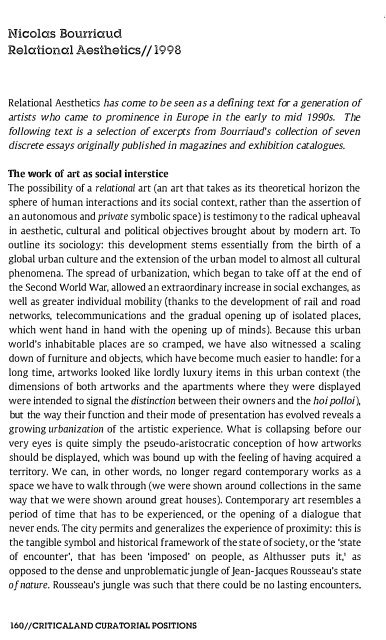You also want an ePaper? Increase the reach of your titles
YUMPU automatically turns print PDFs into web optimized ePapers that Google loves.
Nicolas Bourriaud<br />
Relational Aesthetics/ /1998<br />
Relational Aesthetics has come to be seen as a defining text for a generation of<br />
artists who came to prominence in Europe in the early to mid 1990s. The<br />
following text is a selection of excerpts from Bourriaud's collection of seven<br />
discrete essays originally published in magazines and exhibition catalogues.<br />
The work of art as social interstice<br />
The possibility of a relational art (an art that takes as its theoretical horizon the<br />
sphere of human interactions and its social context, rather than the assertion of<br />
an autonomous and private symbolic space J is testimony to the radical upheaval<br />
in aesthetic, cultural and political objectives brought about by modern art. To<br />
outline its sociology: this development stems essentially from the birth of a<br />
global urban culture and the extension of the urban model to almost all cultural<br />
phenomena. The spread of urbanization, which began to take off at the end of<br />
the Second World War, allowed an extraordinary increase in social exchanges, as<br />
well as greater individual mobility (thanks to the development of rail and road<br />
networks, telecommunications and the gradual opening up of isolated places,<br />
which went hand in hand with the opening up of minds J. Because this urban<br />
world's inhabitable places are so cramped, we have also witnessed a scaling<br />
down of furniture and objects, which have become much easier to handle: for a<br />
long time, artworks looked like lordly luxury items in this urban context (the<br />
dimensions of both artworks and the apartments where they were displayed<br />
were intended to signal the distinction between their owners and the hoi polloi),<br />
but the way their function and their mode of presentation has evolved reveals a<br />
growing urbanization of the artistic experience. What is collapsing before our<br />
very eyes is quite simply the pseudo-aristocratic conception of how artworks<br />
should be displayed, which was bound up with the feeling of having acquired a<br />
territory. We can, in other words, no longer regard contemporary works as a<br />
space we have to walk through (we were shown around collections in the same<br />
way that we were shown around great houses J. Contemporary art resembles a<br />
period of time that has to be experienced, or the opening of a dialogue that<br />
never ends. The city permits and generalizes the experience of proximity: this is<br />
the tangible symbol and historical framework of the state of society, or the 'state<br />
of encounter', that has been 'imposed' on people, as Althusser puts it,' as<br />
opposed to the dense and unproblematic jungle of Jean-Jacques Rousseau's state<br />
of nature. Rousseau's jungle was such that there could be no lasting encounters.<br />
160/ /CRITICALAND CURATORIAL POSITIONS








